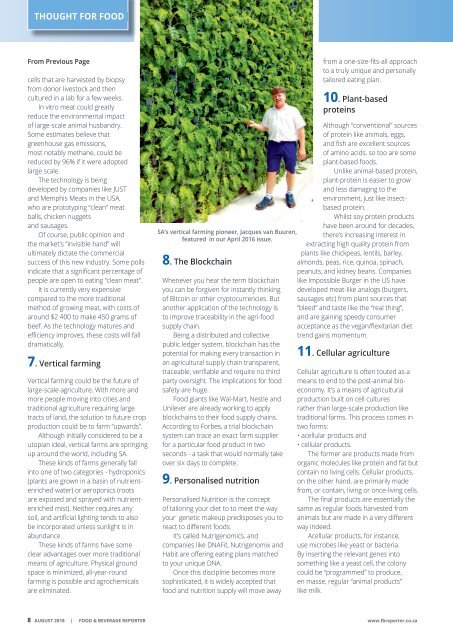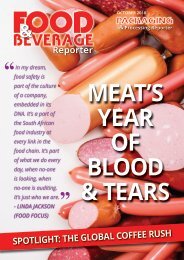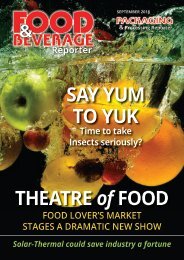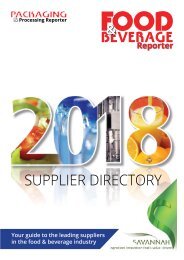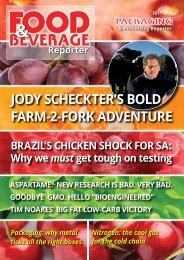Food & Beverage Reporter August 2018
South Africa's leading B2B magazine for the food & beverage sector and its allied industries in processing/packaging etc
South Africa's leading B2B magazine for the food & beverage sector and its allied industries in processing/packaging etc
Create successful ePaper yourself
Turn your PDF publications into a flip-book with our unique Google optimized e-Paper software.
THOUGHT FOR FOOD<br />
From Previous Page<br />
cells that are harvested by biopsy<br />
from donor livestock and then<br />
cultured in a lab for a few weeks.<br />
In vitro meat could greatly<br />
reduce the environmental impact<br />
of large-scale animal husbandry.<br />
Some estimates believe that<br />
greenhouse gas emissions,<br />
most notably methane, could be<br />
reduced by 96% if it were adopted<br />
large scale.<br />
The technology is being<br />
developed by companies like JUST<br />
and Memphis Meats in the USA,<br />
who are prototyping “clean” meat<br />
balls, chicken nuggets<br />
and sausages.<br />
Of course, public opinion and<br />
the market's “invisible hand” will<br />
ultimately dictate the commercial<br />
success of this new industry. Some polls<br />
indicate that a significant percentage of<br />
people are open to eating “clean meat”.<br />
It is currently very expensive<br />
compared to the more traditional<br />
method of growing meat, with costs of<br />
around $2 400 to make 450 grams of<br />
beef. As the technology matures and<br />
efficiency improves, these costs will fall<br />
dramatically.<br />
7. Vertical farming<br />
Vertical farming could be the future of<br />
large-scale agriculture. With more and<br />
more people moving into cities and<br />
traditional agriculture requiring large<br />
tracts of land, the solution to future crop<br />
production could be to farm “upwards”.<br />
Although initially considered to be a<br />
utopian ideal, vertical farms are springing<br />
up around the world, including SA.<br />
These kinds of farms generally fall<br />
into one of two categories - hydroponics<br />
(plants are grown in a basin of nutrientenriched<br />
water) or aeroponics (roots<br />
are exposed and sprayed with nutrientenriched<br />
mist). Neither requires any<br />
soil, and artificial lighting tends to also<br />
be incorporated unless sunlight is in<br />
abundance.<br />
These kinds of farms have some<br />
clear advantages over more traditional<br />
means of agriculture. Physical ground<br />
space is minimized, all-year-round<br />
farming is possible and agrochemicals<br />
are eliminated.<br />
SA’s vertical farming pioneer, Jacques van Buuren,<br />
featured in our April 2016 issue.<br />
8. The Blockchain<br />
Whenever you hear the term blockchain<br />
you can be forgiven for instantly thinking<br />
of Bitcoin or other cryptocurrencies. But<br />
another application of the technology is<br />
to improve traceability in the agri-food<br />
supply chain.<br />
Being a distributed and collective<br />
public ledger system, blockchain has the<br />
potential for making every transaction in<br />
an agricultural supply chain transparent,<br />
traceable, verifiable and require no third<br />
party oversight. The implications for food<br />
safety are huge.<br />
<strong>Food</strong> giants like Wal-Mart, Nestle and<br />
Unilever are already working to apply<br />
blockchains to their food supply chains.<br />
According to Forbes, a trial blockchain<br />
system can trace an exact farm supplier<br />
for a particular food product in two<br />
seconds - a task that would normally take<br />
over six days to complete.<br />
9. Personalised nutrition<br />
Personalised Nutrition is the concept<br />
of tailoring your diet to to meet the way<br />
your genetic makeup predisposes you to<br />
react to different foods.<br />
It’s called Nutrigenomics, and<br />
companies like DNAFit, Nutrigenomix and<br />
Habit are offering eating plans matched<br />
to your unique DNA.<br />
Once this discipline becomes more<br />
sophisticated, it is widely accepted that<br />
food and nutrition supply will move away<br />
from a one-size-fits-all approach<br />
to a truly unique and personally<br />
tailored eating plan.<br />
10. Plant-based<br />
proteins<br />
Although “conventional” sources<br />
of protein like animals, eggs,<br />
and fish are excellent sources<br />
of amino acids, so too are some<br />
plant-based foods.<br />
Unlike animal-based protein,<br />
plant-protein is easier to grow<br />
and less damaging to the<br />
environment, just like insectbased<br />
protein.<br />
Whilst soy protein products<br />
have been around for decades,<br />
there’s increasing interest in<br />
extracting high quality protein from<br />
plants like chickpeas, lentils, barley,<br />
almonds, peas, rice, quinoa, spinach,<br />
peanuts, and kidney beans. Companies<br />
like Impossible Burger in the US have<br />
developed meat-like analogs (burgers,<br />
sausages etc) from plant sources that<br />
“bleed” and taste like the “real thing”,<br />
and are gaining speedy consumer<br />
acceptance as the vegan/flexitarian diet<br />
trend gains momentum.<br />
11. Cellular agriculture<br />
Cellular agriculture is often touted as a<br />
means to end to the post-animal bioeconomy.<br />
It’s a means of agricultural<br />
production built on cell cultures<br />
rather than large-scale production like<br />
traditional farms. This process comes in<br />
two forms:<br />
• acellular products and<br />
• cellular products.<br />
The former are products made from<br />
organic molecules like protein and fat but<br />
contain no living cells. Cellular products,<br />
on the other hand, are primarily made<br />
from, or contain, living or once-living cells.<br />
The final products are essentially the<br />
same as regular foods harvested from<br />
animals but are made in a very different<br />
way indeed.<br />
Acellular products, for instance,<br />
use microbes like yeast or bacteria.<br />
By inserting the relevant genes into<br />
something like a yeast cell, the colony<br />
could be “programmed” to produce,<br />
en masse, regular “animal products”<br />
like milk.<br />
8 AUGUST <strong>2018</strong> | FOOD & BEVERAGE REPORTER www.fbreporter.co.za


